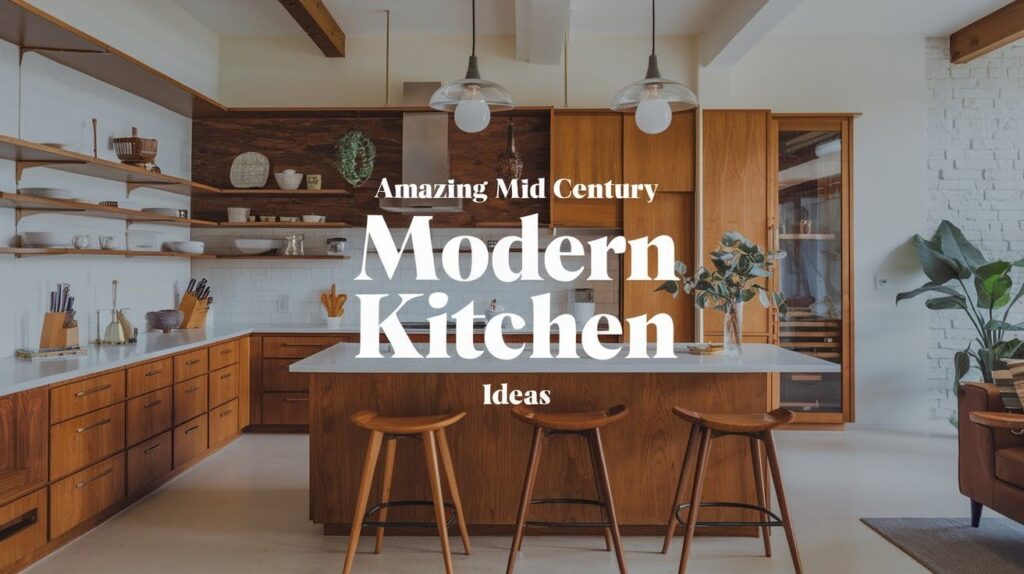Have you ever walked into a kitchen and felt instantly drawn to its sleek, uncluttered design? You might have been experiencing the lasting appeal of mid-century modern style.
Born in the 1940s through 1960s, this design movement emphasized functionality, simplicity, and a strong connection to nature that still captivates homeowners today.
What makes this style so enduring? The clean lines create a sense of calm, natural materials like wood and stone bring warmth, and that subtle retro charm adds personality without overwhelming your space.
The key to success lies in balancing authentic mid-century elements with contemporary updates that keep your kitchen feeling fresh and current rather than like a museum piece.
What Makes Midcentury Modern Kitchens Distinct
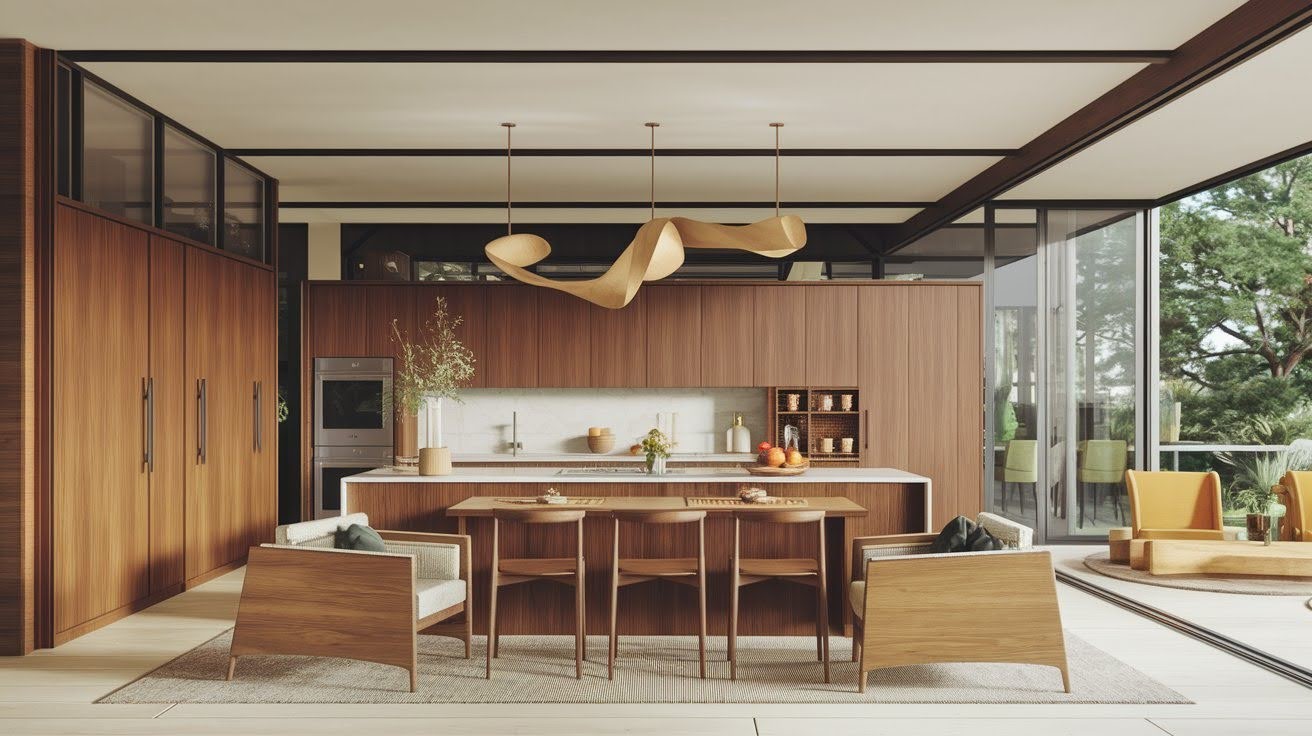
The midcentury modern movement emerged after World War II, when designers wanted homes that felt open, functional, and connected to the outdoors.
Influential figures like Charles and Ray Eames shaped this aesthetic between the 1940s and 1960s, believing kitchens should be efficient workspaces integrated with the rest of the home.
Key characteristics include clean horizontal lines, warm wood tones like walnut and teak, sculptural lighting fixtures, and nature-inspired colors featuring earth tones and muted greens.
This style remains relevant today because it solves modern problems with open floor plans that connect families, quality materials that provide lasting value, and uncluttered aesthetics that work with busy lifestyles while offering a peaceful retreat from our digital world.
43 Amazing Mid Century Modern Kitchen Ideas
Detailed collection of midcentury modern kitchen designs featuring clean lines, warm woods, bold colors, and timeless architectural elements for inspiration.
Color and Material Ideas for Midcentury Modern Kitchens
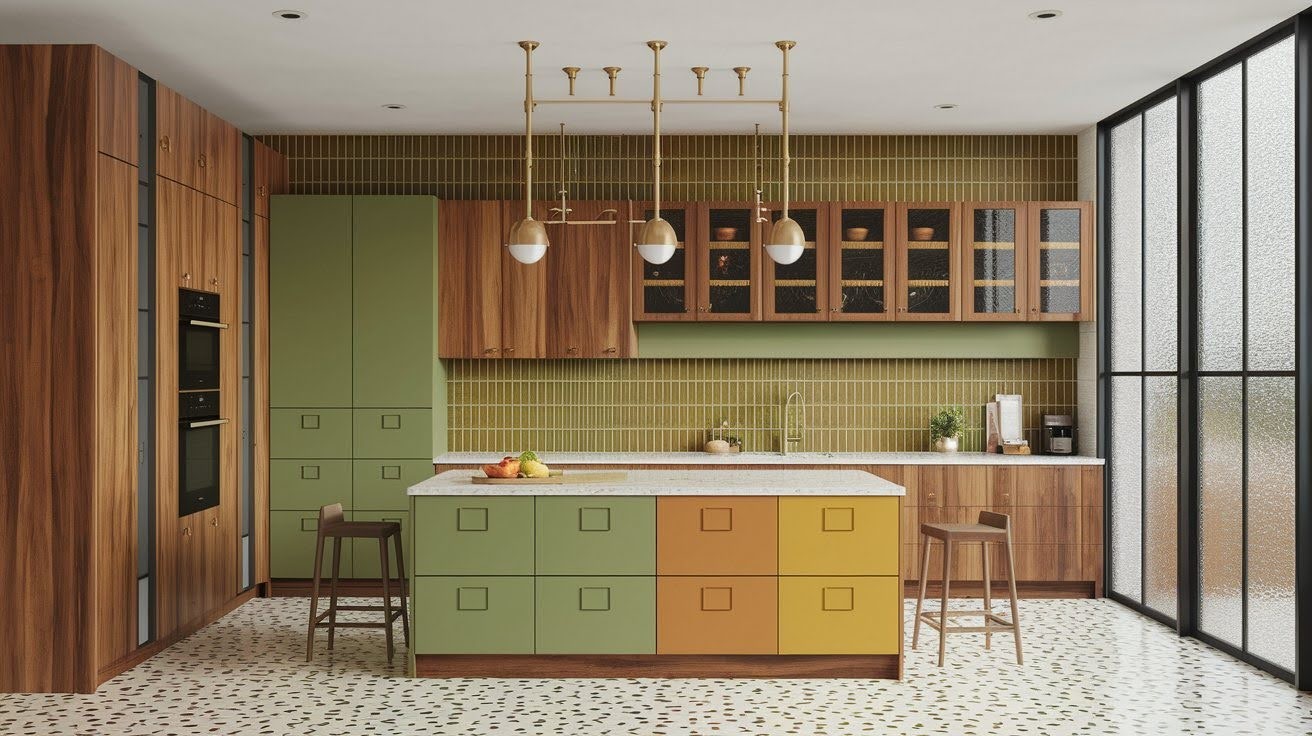
- Pull colors from nature: Draw inspiration from outdoor landscapes with warm browns, forest greens, and sky blues that create a calming, organic feel.
- Use earth-tone finishes: Incorporate rich olive, warm rust, and golden mustard tones on walls or accents for authentic midcentury warmth.
- Add pops of retro color: Introduce classic mint green, avocado, or robin’s egg blue through appliances or small decor pieces for nostalgic charm.
- Bold color blocking on cabinetry: Paint upper and lower cabinets in contrasting solid colors to create visual interest and geometric appeal.
- Two-tone cabinets for contrast: Combine light and dark cabinet finishes to add depth while maintaining the clean, streamlined aesthetic.
- Terrazzo or patterned flooring: Choose speckled terrazzo or geometric vinyl patterns that reference the era’s love for interesting textures.
- Vertical stacked tiles or geometric backsplashes: Install subway tiles vertically or use hexagonal patterns for period-appropriate visual texture.
- Full-wall or waterfall stone backsplashes: Create dramatic focal points with natural stone that extends from counter to ceiling.
- Brass, chrome, or mixed metal finishes: Mix warm brass with cool chrome on fixtures and hardware for authentic midcentury sophistication.
- Decorative glass panels or retro textured windows: Add frosted or textured glass elements that filter light while maintaining privacy.
- Combine natural wood with modern neutrals: Pair warm walnut or teak with crisp black, white, or gray for timeless contrast.
Cabinetry, Woodwork, and Layout Inspiration
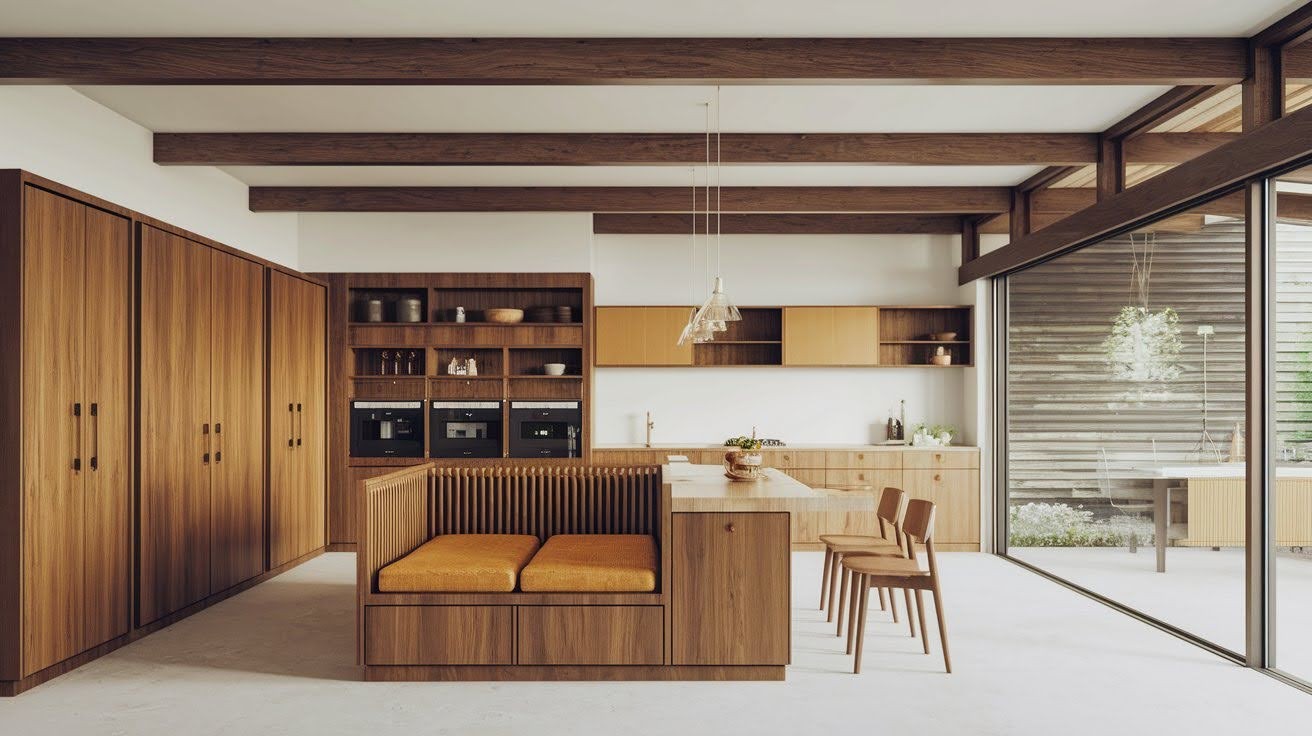
- Flat-front cabinet doors: Choose sleek, handle-free cabinet faces that emphasize clean lines and minimalist geometry typical of the era.
- Custom oak or walnut cabinetry with leather pulls: Install rich wood cabinets with unique leather or wood pull handles for authentic craftsmanship details.
- Mixed wood tones for depth: Combine different wood species like light oak with dark walnut to create visual layers and textural interest.
- Exposed wood beams or ceilings: Show structural elements like ceiling beams to add architectural character and natural warmth overhead.
- Skip upper cabinetry for openness: Remove wall cabinets to create an airy, spacious feeling while showcasing beautiful backsplashes or windows.
- Integrated or hidden appliances: Conceal refrigerators and dishwashers behind matching cabinet panels for a seamless, uncluttered appearance.
- Built-in storage walls and dividers: Create custom storage solutions that serve as room dividers while maintaining open sight lines.
- Open-concept layouts: Remove walls between kitchen and living areas to promote family interaction and entertaining flow.
- Breakfast nooks with slatted dividers or built-in benches: Design cozy eating areas with wood slat screens and integrated seating for intimate dining.
- Indoor-outdoor flow through large windows: Install expansive glass doors or windows that connect kitchen spaces with patios or gardens.
- Add bar seating to islands: Include counter-height seating at kitchen islands for casual dining and social interaction while cooking.
Lighting, Furniture, and Decorative Touches
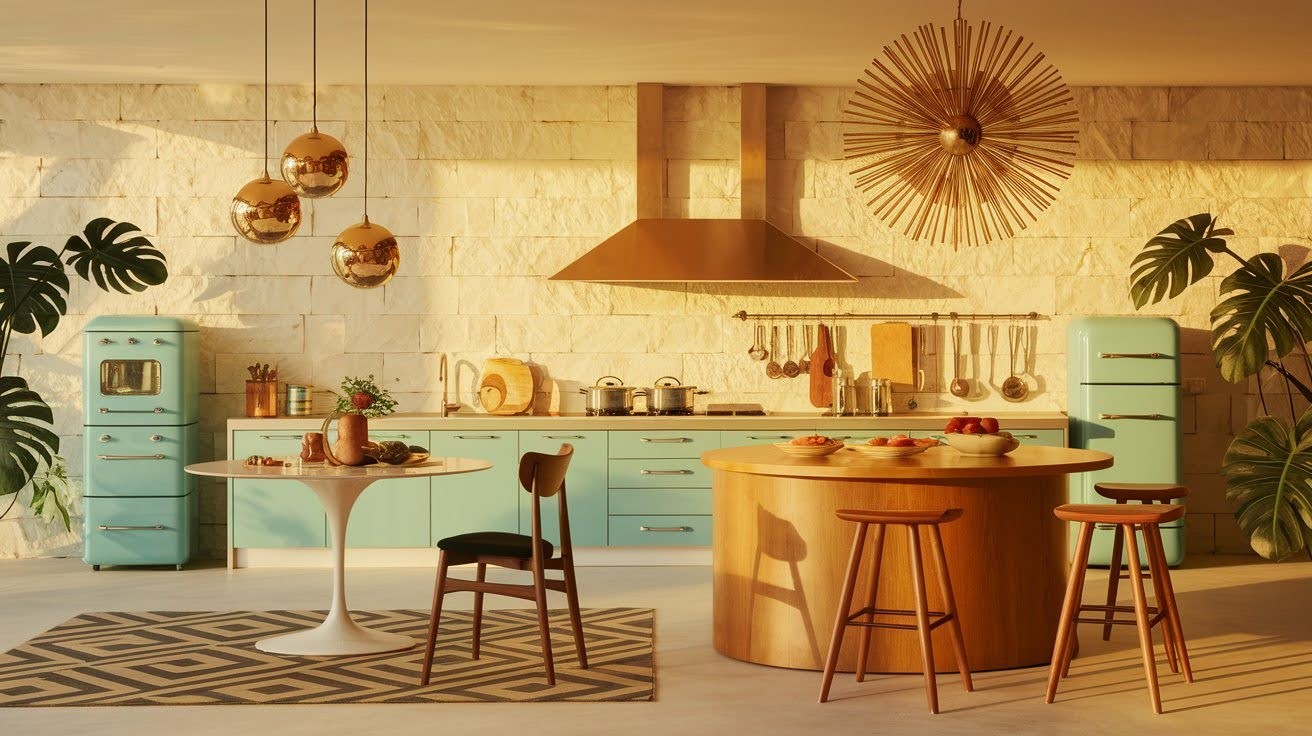
- Globe pendants and Sputnik chandeliers: Install iconic round glass pendant lights or starburst chandeliers that serve as sculptural focal points.
- Space Race-inspired metallic accents: Add atomic-age metallic details in brass, copper, or chrome that reflect the era’s fascination with modern technology.
- Sculptural furniture bases like Saarinen’s Tulip table: Choose dining tables with single pedestal bases that create visual lightness and geometric appeal.
- Danish modern or Eames-style chairs: Select seating with clean lines, molded forms, and wooden or fiberglass construction for authentic period style.
- Wicker and leggy bar stools: Use natural wicker or wooden stools with thin, angled legs that maintain the airy, open feeling.
- Retro appliances in colorful finishes: Install vintage-inspired refrigerators or ranges in mint green, turquoise, or other period-appropriate colors.
- Hang retro art or use period-inspired clocks: Display abstract artwork, geometric prints, or sunburst clocks that capture the optimistic midcentury spirit.
- Add plants for a nature-driven look: Include large leafy plants like monstera or fiddle leaf figs that bring organic shapes indoors.
- Mix patterned rugs or curtains for color and texture: Layer geometric patterns or atomic-inspired designs through textiles for visual interest and warmth.
- Incorporate Danish or Scandinavian midcentury decor pieces: Add teak serving bowls, ceramic pottery, or wooden candleholders for authentic Scandinavian charm.
- Play with layered textures: Combine different materials like smooth wood, rough stone, and polished metal for rich tactile contrast.
Modern Twists on Classic Midcentury Style
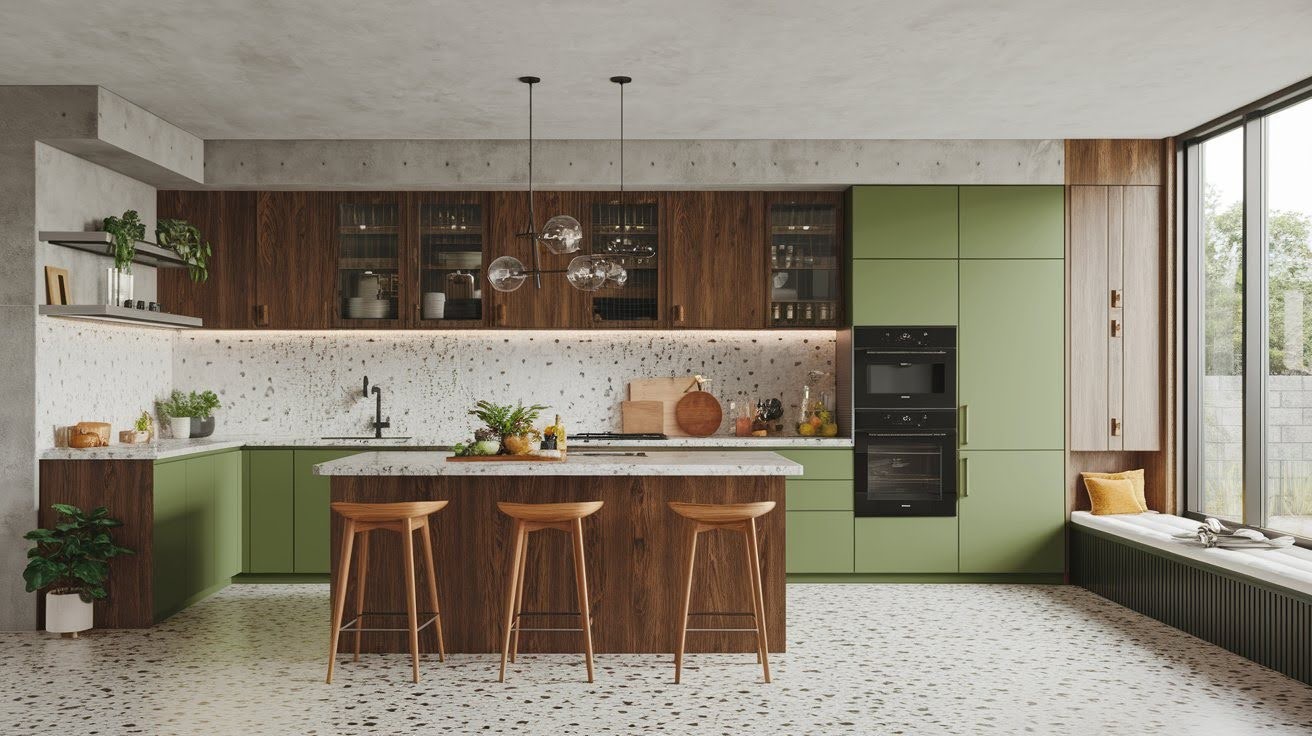
- Blend brutalist or industrial elements with midcentury forms: Combine concrete surfaces or exposed metal with classic midcentury furniture for contemporary edge and contrast.
- Use contemporary neutrals while keeping retro shapes: Apply today’s popular grays and whites to iconic midcentury furniture silhouettes for updated appeal.
- Mix minimalism with warmth: Balance stark, clean surfaces with warm wood tones and cozy textiles for approachable modern living.
- 37. Add dramatic stone countertops with waterfall edges: Install striking quartz or marble counters that flow down island sides for contemporary luxury.
- 38. Try avocado green cabinetry for a signature color: Paint kitchen cabinets in classic avocado green for bold, authentic midcentury character that stands out.
- Celebrate wood grain with black walnut or teak: Showcase natural wood patterns through high-quality walnut or teak cabinetry and furniture pieces.
- Create a full wall of windows for natural light: Install floor-to-ceiling glass panels that flood spaces with daylight and connect indoors with nature.
- Choose terrazzo flooring for vintage appeal: Select speckled terrazzo tiles that reference midcentury aesthetics while offering modern durability and easy maintenance.
- Install built-in breakfast bars or window seating: Add custom seating areas with storage underneath for functional beauty and space efficiency.
- Combine vintage decor with today’s smart appliances: Pair period-appropriate accessories with modern technology for the best of both eras.
Tips for Designing Your Midcentury Modern Kitchen
- Keep clutter minimal to let clean lines shine: Store items in closed cabinets and limit countertop accessories to maintain the streamlined, uncluttered aesthetic that defines midcentury style.
- Mix old and new vintage pieces with modern Appliances: Pair authentic midcentury furniture or decor with contemporary appliances and fixtures for functional living that honors the past.
- Focus on natural light and warm wood tones: Maximize windows and choose rich walnut or teak finishes that create the warm, inviting atmosphere characteristic of the era.
- Don’t overdo color, pick one or two signature shades: Select one bold accent color like avocado green or burnt orange alongside neutral tones to avoid overwhelming the space.
- Use sculptural lighting as both functional and decorative: Choose statement pendant lights or chandeliers with geometric forms that provide illumination while serving as artistic focal points.
- Layer textures (wood, metal, stone) for depth and warmth: Combine different materials like smooth wood cabinets, brass hardware, and stone counters to create visual interest and tactile richness.
Conclusion
The enduring appeal of midcentury modern kitchens lies in their perfect balance of form and function.
These spaces feel as fresh and relevant today as they did seventy years ago because they prioritize what truly matters: clean lines that create calm, natural materials that bring warmth, and open layouts that bring families together.
Don’t feel pressured to create a museum piece. The best midcentury modern kitchens blend authentic retro elements with contemporary conveniences that fit your lifestyle.
Maybe that’s pairing a vintage Saarinen table with smart appliances, or combining classic walnut cabinets with modern quartz counters.
The key is finding your personal balance between honoring the past and embracing the present. Your midcentury modern kitchen should feel uniquely yours while capturing that timeless optimism.
Frequently Asked Questions
What are the key elements of a midcentury modern kitchen?
Clean lines, warm wood tones like walnut or teak, sculptural lighting, and nature-inspired color palettes define the style. Open layouts, flat-front cabinets, and integrated appliances create the streamlined aesthetic.
Can I mix midcentury modern with other design styles?
Yes, midcentury modern pairs well with contemporary, Scandinavian, and even industrial elements. The key is maintaining the clean lines and warm wood tones while adding complementary pieces.
What colors work best in midcentury modern kitchens?
Earth tones like olive, rust, and mustard work alongside classic retro colors like avocado green and mint. Combine these with neutral whites, blacks, and grays for balance.
Are midcentury modern kitchens expensive to create?
Costs vary widely depending on your approach and material choices. You can achieve the look affordably with painted flat-front cabinets and vintage-inspired accessories, or invest in custom walnut cabinetry.
How do I keep a midcentury modern kitchen from looking dated?
Mix authentic vintage pieces with modern appliances and contemporary updates. Focus on timeless elements like natural wood and clean lines rather than trendy color combinations.

